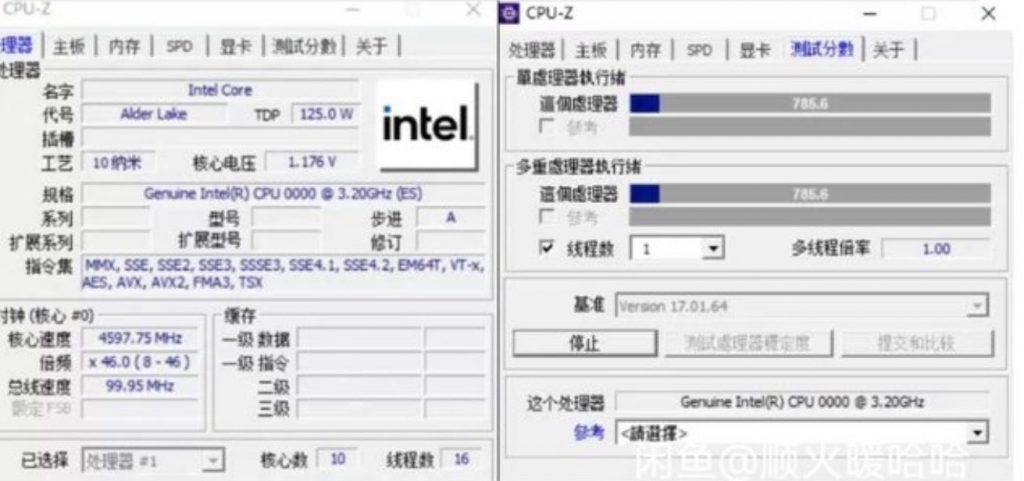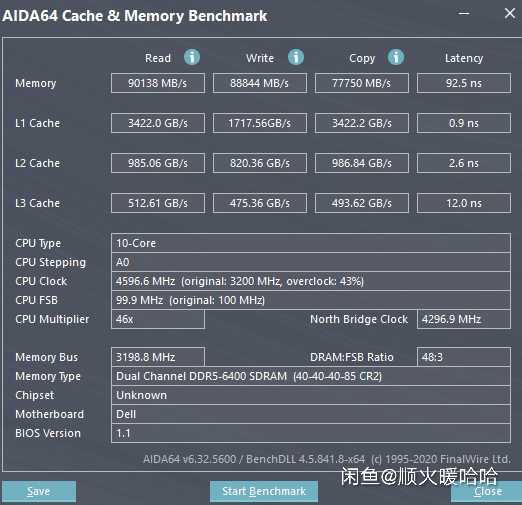How well will fast DDR5 modules perform with Intel Alder Lake?
We have the first benchmark showing what could DDR5 memory be good for. Appearing first with Alder Lake processors and Intel Z690 in November, DDR5 will officialy start at 4800MHz effective clock speed, but a leaked AIDA64 benchmark has already appeared showing the performance at DDR5-6400. It looks like we can expect great bandwidth, but it’s possible that the latency will disappoint, because AIDA shows a scary high value.
This test, which probably originated in China or Taiwan, was pointed out by Korean leaker Harukaze5719 on Twitter. These are AIDA64 and CPU-Z images for an Alder Lake processor equipped with DDR5-6400 memory, i.e. with a frequency of 6400 MHz effectively. They were taken in a motherboard supposedly from Dell, presumably on a prototype of some system of this brand, but it’s clearly a board that will support memory overclocking via XMP profiles. Only the DDR5-4800 frequency will be supported with Alder Lake by default.
The processor is an ES or engineering sample that doesn’t have final frequencies yet, but according to the source, it should probably be similar to the 125W Core i5-12600K, which is a 6+4 core clocked up to 4.9 GHz (for 1 to 2 large cores) or 4.5 GHz for all large cores (more about its specifications here). However, the sample as tseted seemed to have a maximum clock speed of only 4.6 GHz instead of 4.9 GHz. In the CPU-Z test (benchmark version 17.01.64), the processor achieved a score of 785.6 in single-threaded performance. For reference, my Ryzen 9 5950X with DDR4-3600/CL18 and no further tuning has a single-threaded score of 649-650 (though that is on the low side for this CPU, my system is not optimal), so the Alder Lake sample here shows 21% higher single-threaded performance.

DDR5-6400: 88 GB/s read, but over 90 ns latency
The results of DDR5-6400 memory are very nice when we look at throughput: read rate goes up to 90,138 MB/s (88.03 GB/s) in AIDA64, which gives hope that with DDR5-7200 or slightly faster modules (and such have already been announced) we can get up to 100 GB/s. Write rate was only slightly slower, 88,844 MB/s. Copying then reached speeds of up to 77,750 MB/s.
On the other hand, the memory latency shown by this test can be described in many ways but amazing is not one of them. AIDA64 measured 92.5 ns, which is very high especially for today’s optimized gaming PCs. The memories themselves had rather poor timings – 40-40-40-85 with Command Rate 2. This would roughly correspond to the 20-20-20-43 timings on DDR4-3200 (if we disregard the massive difference in memory bandwidth), but with DDR4, that frequency can also be achieved at much tighter timings (commonly with CL16 and 14 is often achievable with manual tuning).

It remains to be seen to what extent it will be possible to acheive better latency values after the release of Alder Lake and the first DDR5 modules. The perpetrator of this test, using an ES processor, may well not have attempted to tune for better values at all, and for all we know, could have even made steps to actually loosen the timings manually. For example, GeIL plans to offer DDR5-6400 modules at CL32-36-36, which would already be quite a bit better than the 40-40-40 timings of the modules used for this test.
Also, AIDA64 benchmark code is likely to not have beeb properly optimized for Alder Lake processors yet, which would mean that real-world performance could be slightly better than what you would expect based on the data. This program tries to measure the best case (optimized) latency and therefore results on an unknown new CPU may not be comparable to results of CPUs the test is already tuned for. Some part of the horrible 92ns latency could perhaps be attributed to this as well.
Gear 4?
To summarise, we do expect Alder Lake to perform better in memory latency in the real world. However, it is possible that one hurdle could be non-negotiable here. We recently featured information that the memory controller will newly have a Gear 4 divider in addition to the Gear 1 and Gear 2, which will reduce the memory controller clock speed to a quarter versus the memory clock speed (to be more precise, this is derived from half the effective clock speed, due to DDR signalling). Gear 4 could make memory latency worse, similarly to what was observed with Gear 2. And it’s possible that this benchmark was actually measured in this Gear 4 mode. If Alder Lake can be persuaded to run without errors at DDR5-6400 speed while still keeping Gear 2 (achieving this at Gear 1 is probably unrealistic), then that alone could improve latency.
Will it be better to stay on DDR4 for gaming?
It cannot be ruled out that, at least initially, memory latencies on DDR5 computers will generally be worse compared to DDR4 because the modules and controllers will not be as well optimised to the excess that DDR4 has benefited from over the long years it has been used for in the market. This could present a setback on gaming performance.
However, if DDR5 initially turns out to be more of a liability rather than boon for games, then there will be an easy solution. This is because Alder Lake also supports DDR4 memory, so gaming PCs will be able to use Z690 boards built for this memory instead. When using DDR4 memory, the performance of the memory controller could probably match today’s Rocket Lake/Core i9-11900K processors, since it is likely carried over from Tiger Lake and Rocket Lake design.
Source: Harukaze5719, via: techPowerUp
English translation and edit by Jozef Dudáš, original text by Jan Olšan, editor for Cnews.cz









Hi,
I have a Trident z5 64gb RGB kit (2x32gb) running on a Asus z790 mboard running xmp performance mode 6400mhz no problem. I can manually change it to 6800mhz with default timings cl32-39-39-102 @ 1.40 running a bombardment of tests. Without fail.
However, at 7000+ it can boot and generally work fine but after using the PC for all sorts of tasks I’ll likely get a couple errors logged. Running 1.45v can get higher mhz but obviously running faster and more voltage I didn’t go any further.
Anyway, as for me I have no problems with stock xmp and voltage at 6400mhz. Tried it with my.old i7-12700k at 5.3ghz all core and my current i5-14600kf @ 5.8ghz 1.25v all p-cores and 4.5ghz all e-core and 48x ring. Using a rtx 4080 and rtx 4090.
As for latency using AIDA64 Engineer it is between 58-64ns
If there is an attachment option I’ll plop it on.
Thank you for the useful insights from practice! 🙂
You can’t add an attachment to comments, but you can upload the data somewhere and insert the link here.